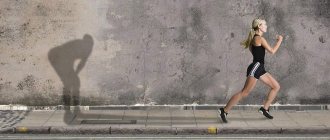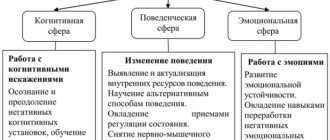Has it ever happened in your life that a storm of emotions suddenly engulfed your entire being and forced you to do something that you later regretted? Has it ever happened that a pre-planned important task was endlessly put off until later due to simple laziness or the presence of “more important” things to do? Sometimes this happens to everyone, and one might even say that it is normal. But these are two manifestations of the inability to control one’s mental state, which, by the way, is very important in life. However, this skill needs and can be developed, and read about how to develop self-control, how to develop self-discipline in our special selection.
1
Objective and subjective methods
Each athlete, especially beginners, should know the basics of self-control when engaging in physical exercise. This will instill the skills of self-analysis and discipline, and will also make the work of a coach, doctor and teacher as effective as possible.
What does self-control mean when doing physical exercise? It is nothing more than monitoring your physical development and health, as well as your tolerance to training and competitive load.
Self-control techniques during physical exercise can be divided into two types. The first of them is objective. Using this technique, you can measure and then quantify anthropological indicators, including body length and weight, chest circumference, etc., as well as compare athletic results and development indicators of a particular muscle group.
The second technique by which you can exercise self-control during physical exercise is subjective. It allows a person to assess his well-being and desire to exercise, mood, fatigue, loss of appetite and other conditions.
Self-monitoring during independent exercise is best done using a diary. It will become a document in which the intensity and volume of sports loads and the results obtained will be recorded. The diary should also reflect subjective and objective characteristics of the state of the body during exercise.
Athlete self-control
Every person should monitor the condition of their own body. It is important to do this for those who are seriously involved in sports. The data obtained will help evaluate the impact of physical activity and the use of various training methods. All results must be recorded in a notebook.
What parameters are used to monitor self-control during physical exercise and sports? The most important of them is well-being. He may be given a good, fair or bad rating. It is through well-being that the general state of the athlete’s body and his central nervous system is reflected. In the absence of negative reactions, we can talk about properly planned training that increases a person’s performance.
Another parameter for self-control is the quality and duration of sleep. That is why the athlete’s diary reflects the processes of falling asleep and waking up, as well as the characteristics of sleep (intermittent, restless, etc.). This parameter is very important for the trainee. After all, it is during a night's rest that recovery processes are activated in the human body. Sleep disturbance, in turn, has a negative impact on the central nervous system and the health of the athlete.
Self-control during physical exercise should also evaluate such an indicator of the body’s condition as performance. It can be good, satisfactory or reduced. As a rule, the highest rating for this parameter can be given if you feel well and have a good sleep. However, this is not always the case. Sometimes an athlete, even if he feels well, experiences decreased performance. If such a phenomenon and reluctance to get physical activity lasts for several days in a row, then you need to notify the trainer about this and at the same time consult a doctor. Poor health can be the result of overexertion.
The state of the body is also characterized by appetite. This parameter is especially important in cases where self-control is exercised during physical exercise. A good appetite indicates normal metabolism in the body. On the contrary, the absence of the need to eat in the morning, as well as in the period 2-3 hours after training, gives reason to assume the presence of disturbances in the functioning of certain organs.
In the process of self-monitoring during physical exercise, the athlete should also pay attention to sweating. This is a normal phenomenon, which also indicates the condition of the body. With good muscle training, sweating decreases. Its increased level with high athletic fitness indicates overfatigue.
In addition to the above subjective data, the self-monitoring diary also reflects parameters such as breathing and pulse rates, as well as weight measurements. They can be used to judge the work of the heart and vascular system, the intensity of the load and the general condition of the body.
The importance of self-control when engaging in physical exercise is great. The data obtained is useful material that allows the athlete and coach to analyze classes and, if necessary, adjust the training plan. However, it is worth keeping in mind that even the most thorough and scrupulous self-control cannot replace the control of doctors.
METHODS OF SELF-CONTROL OF THE FUNCTIONAL STATE OF THE BODY
Function evaluation is possible thanks to the following methods.
- Monitoring heart rate is a simple way to reflect the activity of the heart and blood vessels. The average person's pulse ranges from 60 to 80 beats/minute. The minimum is usually discovered in the morning.
- Pulse rhythm. Or arrhythmia, indicating respiratory dysfunction (more often when inhaling, and less often when exhaling), which is considered normal, or excessive stress.
- The breathing rate is determined taking into account age, level of physical fitness, and training intensity.
Changes in the circulatory and respiratory systems are especially important. They play a decisive role in admission to classes or competitions. But they also pay attention to blood pressure. Deviations from the norm are considered indicators from 130 to 80 mm Hg. and higher, indicating hypertensive conditions. If the numbers are below 100 by 60 mm Hg. Art., hypotension is established.
At Kerdo’s initiative, a formula with the index of the same name (IC) appeared. The norm is calculated from it using the ratio: IR=D/P, where:
- D—minimum pressure;
- P - pulse.
It is a known fact: the norms for minimum blood pressure and pulse are numerically the same. That is, for a person without disorders, the index is approximately equal to one. If there is a deviation in the functioning of the cardiovascular system, the numerical value turns out to be greater or less. Such failures are caused by improper nervous regulation.
They also independently monitor physical development: height, weight, chest circumference, taking measurements.
For those who conduct independent training
Self-control techniques during physical exercise should be used not only by athletes. They are also important for those who are simply interested in swimming, cycling, running, etc. The data obtained during self-control in this case is also recorded in a diary, which has some differences from the athlete’s diary.
It is recommended for those who independently engage in physical training to record not only information about the muscular work performed and the body’s reaction resulting from it. This diary also reflects data at rest.
Medical supervision
Self-control in the process of physical education is complemented by medical, including a comprehensive examination of functions. Why is this necessary? The goal is to study the consequences of loads received in physical education classes. Thus, in universities every year, 3 medical groups of students are identified through examination.
- The main one has almost no deviations. These persons can participate in competitions without restrictions and perform all programs.
- Preparatory, with satisfactory development and condition. Here the load increases gradually.
- Persons from the special group were found to have chronic diseases, illnesses, and developmental disabilities. They study according to a special program after consulting a doctor or physical education teacher.
Athletes undergo such examinations twice a year.
Height and weight control
The body shape and performance of the human body undergo changes throughout his life. But this process can be observed especially actively during training. Methods of self-control during physical exercise, which determine the characteristics and level of development of the body, include the determination of anthropometric standards, indices and correlations. The data obtained make it possible to identify those changes in physical development that occur due to training.
In order to exercise self-control during independent physical exercise, it is necessary to take anthropometric measurements of the circumference of the chest, abdomen, waist, lower leg and thigh at a certain frequency (month, week, etc.), as well as record body weight. It is recommended to record the strength of the muscle hand, as well as the amount of body fat, in the self-monitoring diary.
When conducting self-monitoring during independent physical exercise, it is important to monitor such characteristics as body length and weight. These indicators are the most important.
It is worth keeping in mind that the greatest growth in humans is observed in the morning. After intense training, as well as in the evening, body length decreases by two centimeters or more. Thus, when performing exercises with a barbell, the intervertebral discs become compacted. This causes a decrease in the athlete's height by 3-4 centimeters.
As for body weight, this objective indicator of the state of the body also changes during physical activity. This is especially noticeable in the initial stages of sports. Changes in body weight occur due to the combustion of fat and the release of excess water. After this, the weight stabilizes. Further values of this anthropometric indicator will depend on the focus of training. An athlete’s body weight can either decrease or increase. A person who exercises self-control in the process of independent physical exercise is able to analyze his training. So, if the body receives light loads, then body weight decreases within three hundred grams. The average intensity of exercise allows you to get rid of 400-700 g. Heavy load causes weight loss of 800 g or more.
Body weight can also be controlled using the Broca-Brugsch index. Body weight, according to this indicator, is equal to the height of the human body, reduced by one hundred.
When self-monitoring the state of the body during sports training, the Quetelet weight-height index can be used. To calculate it, you need to divide body weight by height. The norm is considered to be a condition when per centimeter of height is calculated from 350 to 400 g of weight in men and from 325 to 375 g in women.
Why is a high level of self-control dangerous?
An excessive level of self-discipline leads to constant mental stress. The ability to freely express feelings disappears.
Feelings tend to accumulate. They come out on their own at the most inopportune moment or are expressed in the form of the acquisition of diseases.
According to statistics, up to 63% of secluded individuals are susceptible to heart disease and gastrointestinal diseases.
To avoid such developments, it is necessary to engage in prevention. Shouting into the air in deserted places and breaking dishes help relieve accumulated tension. Some martial art classes are shown.
Our demons will never die - they are always nearby. Demons walk holding our hand, whisper and hug us during sleep. No one is able to drive them away, but no one is able to build coexistence. Someone will take the path of ignoring. Someone will turn into a slave. And someone establishes control over them and every second monitors compliance with the rules that he himself established. Victor Usmansky.
Techniques called auto-training have proven themselves to be excellent. It normalizes the psychological state and gives a tangible positive effect in teaching self-control.
Other indicators of physiological development
When conducting self-control, it is important to measure the chest circumference. Its good development is a guarantee of good health. You need to examine the chest circumference at rest, measuring this indicator both during inhalation and exhalation. The difference in the obtained values is nothing more than an excursion of the chest. It depends on the type of breathing and muscle development.
When exercising self-control during sports, it is necessary to measure the muscle strength of the arms. For this there is a special device called a dynamometer. Indications of arm muscle strength are directly dependent on chest circumference, body weight, etc. Typically, the strength of men's arms is 60-70 percent of body weight, and women's – 45-50%.
During self-control, muscle strength is also measured. This is the strength of the spinal extensor muscles. Its value directly depends on age and gender, occupation and body weight.
Self-monitoring of the student also includes spirometry. In this case, vital capacity is measured - the volume of air exhaled from the lungs. The values of this indicator characterize the elasticity of the lung tissue and the strength of the respiratory muscles.
Books
- "Resilience" by Sharon Melnick
- "The Psychology of Emotions: Feelings in Control" Dan Dubravin
- "Strength of will. How to develop and strengthen" Kelly McGonigal
- "Developing Willpower" Walter Mischel
- "On the limit. A week without self-pity" Eric Bertrand Larssen
- The Psychology of Achievement by Heidi Grant Halvorson
- “Get out of your comfort zone. Change your life. 21 methods for increasing personal effectiveness" Brian Tracy
- “Don't put it off until tomorrow. A short guide to fighting procrastination by Timothy Pychyl
- “18 minutes. How to increase your concentration, stop distractions and get things done that really matter." Peter Bregman
- "Be the best version of yourself" Dan Waldschmidt
Sometimes, in order to develop self-control, you need to constantly think about it. What dominates thoughts becomes something tangible and we begin to be aware. So don't just think about this skill, but also get a lot of information: read blogs, books, watch videos on this topic.
We wish you good luck!
Did you like the article? Join our communities on social networks or our Telegram channel and don’t miss the release of new useful materials: TelegramVKontakteFacebook
We also recommend reading:
- Storytelling
- Flow state: what is it and how to enter it
- Self-control: what it is and how to develop it
- Overcoming Negative Behavior
- Self-control and self-motivation
- Best of the year. Part two
- 6 Scientific Ways to Make Decisions
- 10 Ways to Improve Willpower
- Will and volitional actions
- Ways to train and develop willpower
- How to develop self-control and self-discipline
Key words:_D1034, 1Psychoregulation, 4Psychoregulation
Control over the functioning of blood vessels and the heart
When exercising, it is important to pay attention to how you feel. It expresses the response of systems and organs of the human body to physical activity. The most important indicator in this case is the indicators of changes in the functioning of the respiratory organs, as well as blood vessels and the heart.
What are the methods of self-control when doing physical exercises in this case? To decide on a particular training load, heart rate (HR) and blood pressure are measured. A person’s performance largely depends on these indicators.
Heart rate
What are the methods of self-control during physical exercise that allow you to determine this value? For example, to measure resting heart rate, the trainee must be in a sitting position. In this case, it is necessary to feel the temporal, carotid or radial artery, counting the heart beats for five seconds. This must be done two or three times in a row. After receiving the data, the average value is multiplied by 12. This makes it possible to find out the number of heart beats per minute. In untrained people, heart rate is 60-89 beats/min.
Exceeding the normative limits indicates the likelihood of tachycardia, and a rarer pulse may indicate bradycardia. Also, a high heart rate (80-85 beats/min) at rest indicates fatigue of the body. Of course, after training, a person’s pulse increases. However, normally the body should spend from five to ten minutes to restore it. This characteristic will indicate optimal physical activity.
What affects the ability of self-control: 4 main factors
Daily regime
First of all, it means getting enough hours of sleep. There can be no talk of any self-control if you sleep less than 7 hours. Concentration suffers, without which control is impossible. In addition, it is unacceptable to fall asleep late at night, especially in the morning. The nervous system - the mother of willpower - cannot withstand such a regime, and accordingly it will not be able to provide the resource. Sleep is not rest, but restoration of the body for a productive day.
Here and now
The harmful habit of postponing everything for later is firmly ingrained in a person’s consciousness, creating the illusion of temporary release from responsibility. Discipline begins with her. Psychologists emphasize the importance of accustoming yourself to doing everything “now,” thereby solving the problem on the spot. But then comes a sweet feeling of relief that the job has already been done, and now you can relax a little without remorse. Soon “here and now” becomes a habit and ceases to require willpower.
Ignoring irritants
Troubles with colleagues, capricious children, bad weather, a toxic environment, unpleasant surprises (a stain on a new shirt), late transport - nothing should affect self-control.
and personal performance.
“I smoked a cigarette because my nerves were frayed”, “tomorrow I’ll work on a project because there’s no muse today” - this is not an excuse, this is self-deception. No muse? Let's drag her by the ears!
The subconscious does nothing but look for a reason to succumb to weakness and self-sabotage. One thing is important here: nothing is a reason to be lazy except your health.
Distance
Now this word can be heard at every step, but we are talking about mental distance. Staying away from temptation is not so difficult: just turn off your phone while preparing for an exam (or work), and the world outside your window will go offline in a second. When doing any business, first of all, you need to weed out any sources of temptation. As for bad habits, it is important to distance yourself from the reality where these habits are relevant. At least create an imaginary wall between yourself and others.
Arterial pressure
This indicator is objective. It is no secret that certain fluctuations in blood pressure indicate the rhythm of cardiac activity.
There are various types of self-control during physical exercises, used in sports practice, which allow one to assess the state of the body. Among them are functional tests. So, with independent physical training, it is recommended to do twenty squats in half a minute. After this, the trainee must sit quietly for 3 minutes. A heart rate from 100 to 130 beats/min after physical activity will indicate a low level of load, 130-150 beats/min will indicate average intensity.
Sometimes the pulse with this method of self-control can increase to 150-170 beats per minute. This indicator is typical for the maximum load. The obtained values are an excellent guide for self-control.
Definition
Control can be internal - directed at oneself, or external - regulating the activities of others. When control mechanisms are aimed at analyzing and regulating one’s “I”, this process is called the discipline of self-control.
It is one of the indispensable factors of a person’s self-awareness and is a condition for adequate perception of the internal and surrounding world.
The following types of self-control are distinguished:
- temporal;
- spatial;
- arbitrary.
The temporary type is divided into preceding, current and effective subtypes, combining a preliminary assessment of the process, control of the action itself and analysis of the results of the action.
Are you ready to stop thinking about your problem and finally move on to real actions that will help you get rid of your problems once and for all? Then perhaps you will be interested in this article .
Spatial self-control regulates the difference between perceptual modal channels. It is divided into auditory, tactile and visual.
The type of self-control of an arbitrary type regulates variables that are not expressed by a constant: emotions, psyche, thinking.
State of the nervous system
The central nervous system is the most complex of all body systems. It consists of brain sensory centers designed to analyze changes in both the external and internal environment. They are the ones who control all the functions of the human body. The main task of the central nervous system is to accurately and quickly transmit the necessary information. The operation of this system also needs to be checked when performing self-monitoring during sports. For this purpose, there is a method of conducting an orthostatic test. The results of such a study reflect the excitability of the central nervous system.
To obtain the necessary data, a person must take a lying position, rest for 5-10 minutes and count his pulse. Next, you need to stand up and measure your heart rate while standing. The difference in heart rate values over one minute will indicate the state of the central nervous system. So, with weak excitability this value will be from 0 to 6, with normal - from 7 to 12, and with lively and increased, respectively, from 13 to 18 and from 19 to 24 beats per minute.
Self-monitoring of the functioning of the nervous system is also recommended through observations of the skin-vascular reaction of the body. It is determined by rubbing the skin several times with any non-sharp object. If the place of pressure turns pink, then this reaction will indicate that the body’s vascular response is within normal limits. White or red coloring of the skin area will indicate high or increased innervation of the skin vessels, observed, as a rule, during overwork, during illnesses or when they are not completely cured.
To self-monitor the functioning of the central nervous system when performing physical exercises, you can do the following:
- Romberg test, which detects imbalance;
- Yarotsky test, which determines the sensitivity limit of the vestibular apparatus;
- finger-nose test.
How to learn to control your thoughts
How to become a happy woman - is it possible to learn cheerfulness?
In psychology, special attention is paid to the question of how to control your thoughts. It is no secret that conditions such as anxiety, pathologies and phobias are formed when a person ceases to control negative thoughts, and they begin to take over consciousness.
For your information. In most cases, thoughts arise and disappear spontaneously. According to experts, only yogis, plunging into a trance, can turn off the flow of thought, since they master the highest form of working with thought. The average person cannot undertake such a test of thinking; it requires many years of work on oneself. But this does not mean that you cannot find a way to learn to control your thoughts.
Experts warn that it is easier to control thoughts if people can:
- don’t be nervous about criticism and don’t get hung up on it;
- do not engage in self-criticism, so as not to destroy your brain with obsessive thoughts;
- set realistic goals that are accessible and can be realized;
- evaluate yourself adequately;
- cope with fears and guilt.
Self-control methods seem quite easy, but they require effort on yourself. Often psychologists offer patients a functional “white room” technique for teaching self-control. The essence of the exercise is to imagine your consciousness as a “white room with two doors” and observe what thoughts pass through it. The exercise is performed in a secluded place, the main thing is to be able to relax using any convenient method of relaxation. Then, maintaining even breathing and the image of a “white room,” monitor and filter your thoughts.
Thoughts, according to psychologists, can be evaluative (stuck in the mind) and non-evaluative (easily floating away). Consider each one carefully, but don’t try to analyze it, give it the opportunity to live your life and drive it out the door. Perform this exercise as many times as necessary to understand that you can distance yourself from thoughts, even stuck ones.
By developing positive skills and overcoming shortcomings, a person gains inner confidence and self-control, and achieves success in professional and educational activities.
Application of hygiene rules
Each person, in addition to self-control over the performance of sports exercises, must be able to properly organize their work and rest. In other words, follow the rules regarding personal hygiene. This concept includes a number of factors, namely:
- maintaining a daily routine;
- balanced diet;
- hygiene of the body, shoes and clothing;
- rejection of bad habits.
Strict adherence to all these rules is an important factor in maintaining normal performance and maintaining health.










